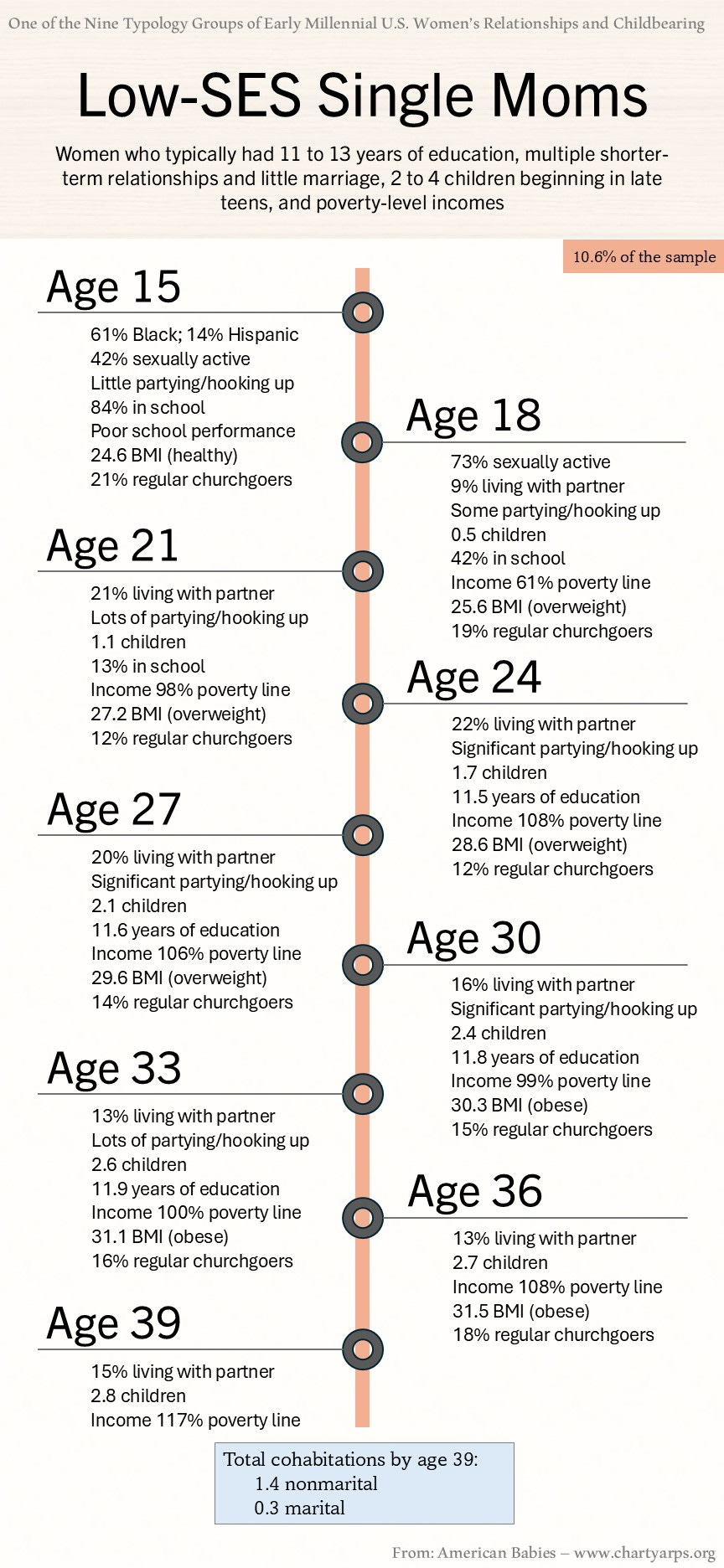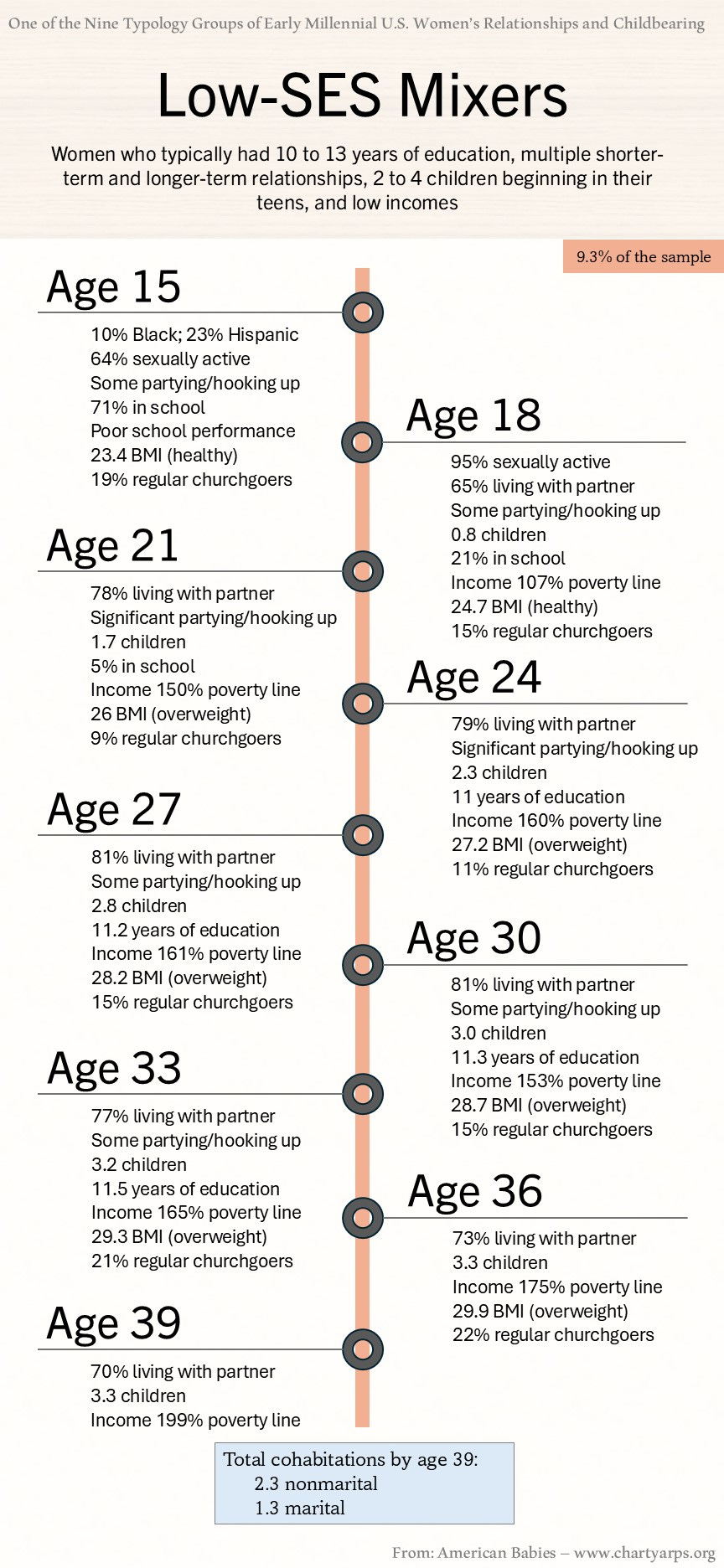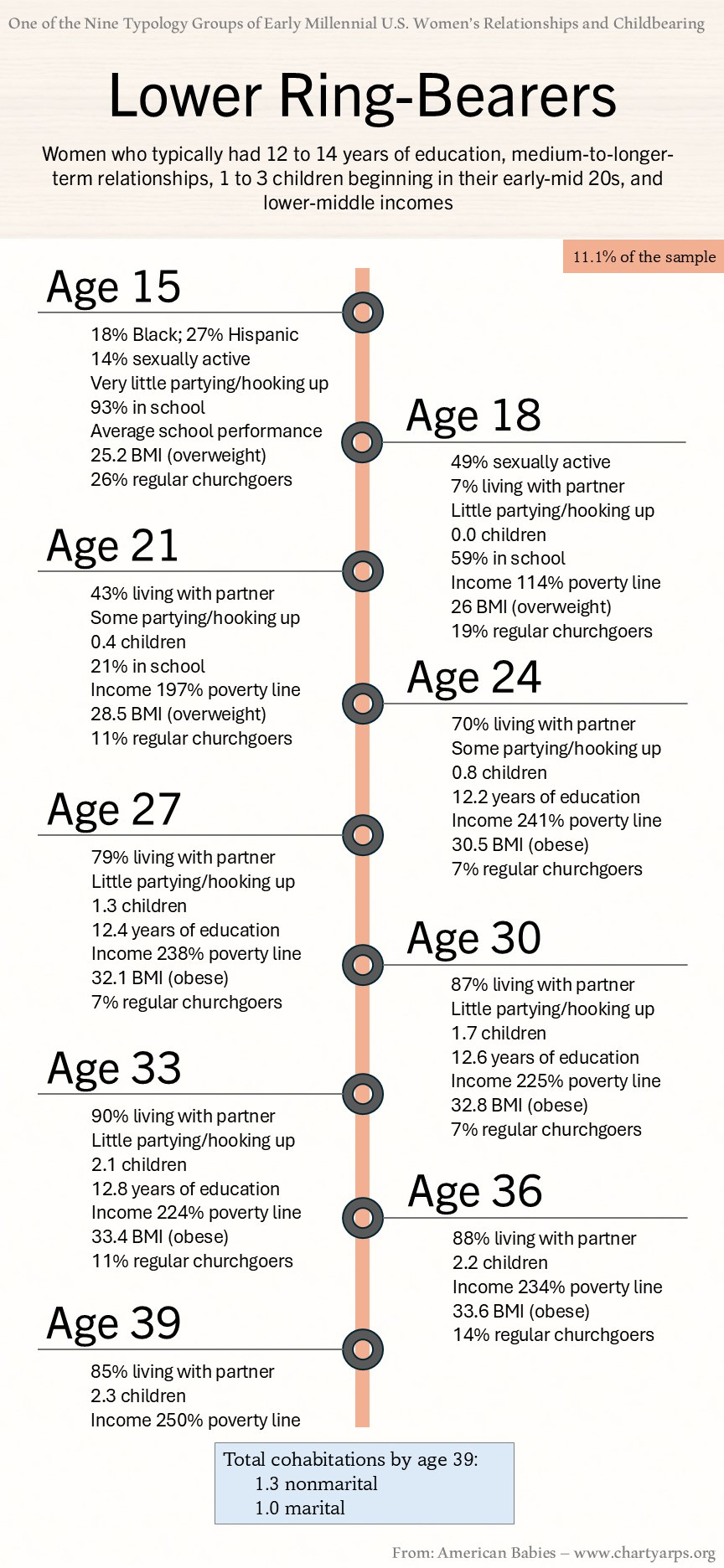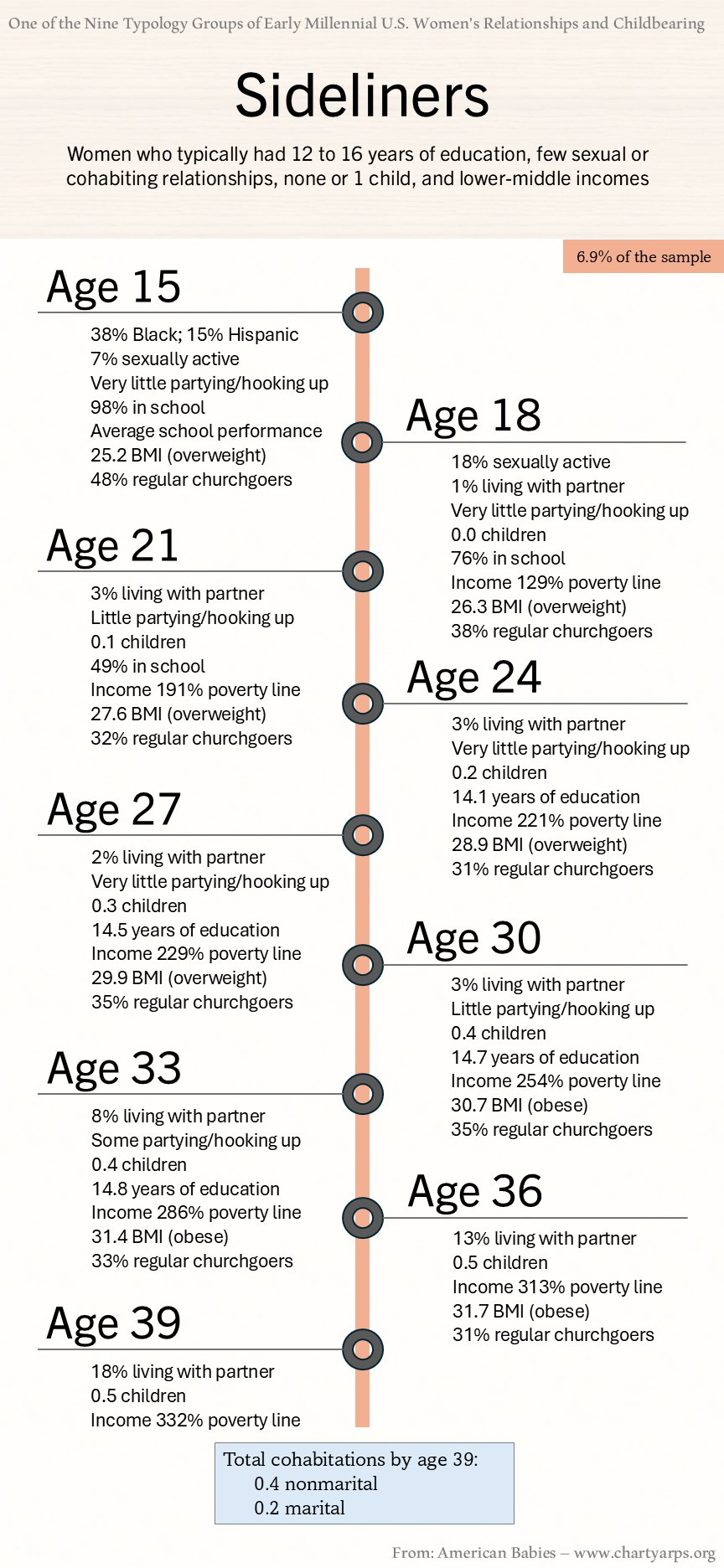Relationship and childbearing patterns at lower socioeconomic levels
The different paths of early Millennial women in the U.S.
Using data from the National Longitudinal Survey of Youth 1997 (NLSY97), I’ve been working through nine distinct groups for early Millennial U.S. women’s sexual, relationship, economic, and childbearing patterns.
A couple of posts ago, I described two clusters, both with higher socioeconomic status (SES), but with widely contrasting sexual and childbearing patterns. Whereas the High-SES Freewheelers had multiple short-term partners throughout their 20s and 30s, with little marriage and typically had no children or one child by age 39, the Higher Ringbearers were relatively abstinent prior to entering into stable marriages and typically had two or three children.
In yesterday’s post, we looked at three more groups:
High-SES Mixers, who combined really high SES (lots of education and income) with partying/hooking up rates similar to High-SES Freewheelers in their college years, but then transitioned to stable marriages and children in their late 20s and early 30s, typically having 1 or 2 children by age 39 – that is, they mixed together the shorter-term activities of Freewheelers with the longer-term relationships of Ring-Bearers, which is why they’re called “Mixers”.
Mid-SES Mixers, who look a lot like High-SEX Mixers except they have shorter educations and then everything else is accelerated by a few years – so, the Mid-SES Mixers started having sex a few years younger than High-SES mixers, experienced their peak party years a few years younger, started living with a partner a few years younger, and had their first child a few years younger. This faster timeline left Mid-SES Mixers with more kids but less income than High-SES Mixers.
Mid-SES Freewheelers, who, like High-SES Freewheelers, had multiple shorter-term relationships and little marriage, but hit all the milestones a few years younger than High-SES Freewheelers, and ended up with shorter educations (typically having some college attendance but no degree), and less income but more children on average.
Today we’ll look at the remaining four groups. Three of these are groups with lower SES and the last is in a sense off the grid, consisting of women who didn’t ever really have sustained participation in the mating game (at least not with men, though the NLSY97 doesn’t give a clear way to track same-sex sexual activity).
Low-SES Single Moms:
This is the prototypical “underclass” pattern, involving a combination of truncated educations, few longer-term relationships, higher numbers of children beginning in teen years, and persistently very low household incomes, typically just at or below the poverty line.
Low-SES Single Moms weren’t big-league partiers like the Mid-SES Freewheelers and High-SES Freewheelers, so I’m hesitant to call this a “Freewheeler” pattern, though it’s in that ballpark. A good portion of the Low-SES Single Moms likely arrived at that pattern based on decision constraints. This group had poor standardized test performance and low grades, which constrained their educational options.
In addition, this group consists mostly, though not exclusively, of Black women, who can face unique challenges in forming longer-term relationships given the relative scarcity of living, non-incarcerated Black men. To appreciate the point, imagine a reality show involving heterosexual single people in their 20s who haven’t previously met each other. They’re put on one of two islands for a year to live as a community. On the first island, 100 women reside with 102 men. On the second island, 100 women reside with 85 men. It’s not hard to guess which island will produce the higher proportion of women forming stable monogamous relationships.
Low-SES Mixers:
Here we see a Mixer pattern (i.e., involving a mix of both shorter-term and longer-term relationships) together with a low-SES pattern (i.e., poor test scores and grades, shortened educations, and low incomes). What you see, then, is a mix of relationship types beginning astoundingly early, leading eventually to very high average fertility. This group generally began cohabitation and marriage and childbearing beginning in their teen years, never engaging in a significant partying/hook-up phase and generally ending their educations with a high school diploma, a GED, or less. Most had their first kid when the women were teenagers living with their partner. They averaged 2 children by age 24 and ended up with around 3 or 4 by age 39. Most had persistent economic struggles, with household incomes less than 200% of the poverty level.
Lower Ring-Bearers:
On socioeconomic status, this is a group that is in between the “Low-SES” and the “Mid-SES” groups. While their education levels were about the same as the “Mid-SES” groups, their household incomes were around 230% of the poverty level, which is below the “Mid-SES” groups.
I’ve tagged them as Ring-Bearers, though they’re a less-prototypical version than the Higher Ring-Bearers. These Lower Ring-Bearers largely abstained from partying and hooking up as teens, started living with a partner and having kids in their early 20s, and they ended up with around 2 children. In a related set of circumstances, as compared with Higher Ring-Bearers, these Lower Ring-Bearers have more non-marital cohabitations than Higher Ring-Bearers, fewer children, and are generally not attending religious services.
Some of the differences between Higher and Lower Ring-Bearers probably relate to socioeconomic starting points. And a particularly striking difference concerns body mass index (BMI). Lower Ring-Bearers are the most overweight group, with average BMIs above the “obese” category starting in their early-mid 20s. Higher Ring-Bearers, in contrast, are essentially tied with Mid-SES Mixers as the second-thinnest group, with the thinnest group being High-SES Mixers.
Sideliners:
And now for something completely different. These women started off a bit like Higher Ring-Bearers — avoiding sex and partying, pursuing educations, and more likely to be churchgoers — but then never really ended up transitioning into the (heterosexual) mating arena. At any given year through the survey period, they were unlikely to have had any (male) sex partners at all. Most ended up without any biological children by age 39. (Unfortunately, the NLSY97 doesn’t ask about same-sex sexual activity, so I can’t readily tell to what extent this group contains lesbians — though I suspect that’s only a fraction of what’s going on with this group.)
OK, so those are the nine pattern clusters of how early Millennial women navigated education, shorter- and longer-term sexual relationships, and having children. You have a couple of major intersecting factors. One is high vs. low socioeconomic status, with longer educations and career development typically delaying longer-term relationships and childbearing. The other major theme involves having multiple shorter-term relationships vs. stable longer-term relationships (vs. none of the above).
Then there are some big constraints pushing women one way or another along these dimensions. Primarily, having the resources (mental, financial, etc.) to succeed in higher education is a huge determinant of how far women actually go with higher education. Another significant constraint is on the availability of longer-term partners for Black women. As I discussed above, this relates centrally to the sex-ratio imbalance created by the disproportionate incarceration and death rate of young Black men. Another set of constraints is likely to involve the preferences of men, which of course partially determine womens’ relationship status/outcomes.
I gave a preview of the big picture at the end of yesterday’s post, and here’s another way to approach it:
Surely most folks working in office buildings would like to live in spacious homes that are close to where they work and are also relatively inexpensive. So why don’t they all just do that? The answer: Because typically such homes do not exist. Spacious places are generally more expensive, as are places that are close to office buildings where lots of people work. So what do people do instead? It turns out they splinter into different patterns, some maximizing space over price and proximity, some maximizing price over space and proximity, and so on. Where they end up is partially determined by constraints – maybe some have very little money and simply have to seek out very inexpensive places that tend to be less spacious and farther from where lots of people work, or maybe some have a bunch of young children and really must maximize space relative to price and distance, and so on.
This is, I think, a pretty apt analogy for what’s going on with the NLSY97 clusters where the Rich-Sexy-Lots goals I described yesterday have inherent trade-offs and constraints, leading to widely diverse outcomes even if you think that most started with a similar kind of starting point.
Most workers probably would prefer homes that are simultaneously big, close, and cheap if they could get it — but that’s not typically realistic, so they splinter into groups with different trade-offs.
Similarly, most young women might prefer an adult life in which (1) they are Rich (e.g., by getting lots of education and then marring a prince from a fairy tale or a Christian Grey type from a romance novel), (2) their partners are Sexy (e.g., it’s not just any prince in the fairy tales, but a handsome and charming prince, and in romance novels the male conquest is typically a previously untamed bad boy), and (3) they have at least two or more (maybe even Lots of) offspring who will be likely to inherit both the Riches and the Sexiness. But that’s not realistic, so they splinter into groups with different trade-offs.
It of course doesn’t all boil down to something so simple, but it’s a way to make sense of the broad patterns we see in these data.





